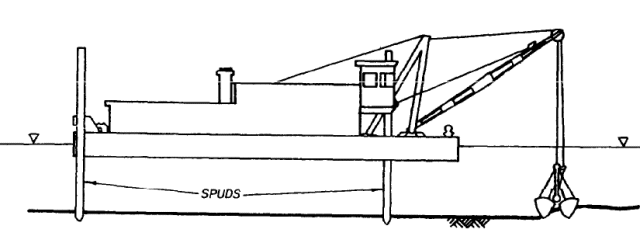Bucket Dredges
The bucket type of dredge is so named because it utilizes a bucket to excavate the material to be dredged. Different types of buckets can fulfill various types of dredging requirements. The buckets used include the clamshell, orangepeel, and dragline types and can be quickly changed to suit the operational requirements. The vessel can be positioned and moved within a limited area using only anchors; however, in most cases anchors and spuds are used to position and move bucket dredges. The material excavated is placed in scows or hopper barges that are towed to the disposal areas. Bucket dredges range in capacity from 1 to 12 cu yd. The crane is mounted on a flat-bottomed barge, on fixed-shore installations, or on a crawler mount. Twenty to thirty cycles per hour is typical, but large variations exist in production rates because of the variability in depths and materials being excavated. The effective working depth is limited to about 100 ft.
The bucket type of dredge is not self-propelled but can move itself over a limited area during the dredging process by the manipulation of spuds and anchors. A typical sequence of operation is as follows. The bucket dredge, scows or hopper barges, and attendant plant are moved to the work site by a tug. The dredge is positioned at the location where work is to start and the anchors and spuds lowered into place. A scow or hopper barge is brought alongside and secured to the bucket dredge hull. The dredge begins the digging operation by dropping the bucket in an open position from a point above the sediment. The bucket falls through the water and penetrates into the bottom material. The sides or jaws of the bucket are then closed through the use of wire cables operated from the crane. As the sides of the bucket close, material is sheared from the bottom and contained in the bucket compartment. The bucket is raised above the water surface and swung to a point over the hopper barge. The material is then released into the hopper barge by opening the sides of the bucket. As material is removed from the bottom of the waterway to the desired depth at a given location, the dredge is moved to the next nearby location by using anchors. If the next dredging area is a significant distance away, the bucket dredge must be moved by a tug. The loaded barges are towed to the disposal area by a tug and emptied by bottom dumping if an open water disposal area is used. If a diked disposal area is used, the material must be unloaded using mechnical or hydraulic equipment. These procedures are repeated until the dredging operation is completed.
Bucket dredges may be used to excavate most types of materials except for the most cohesive consolidated sediments and solid rock. Bucket dredges usually excavate a heaped bucket of material, but during hoisting turbulence washes away part of the load. Once the bucket clears the water surface, additional losses may occur through rapid drainage of entrapped water and slumping of the material heaped above the rim. Loss of material is also influenced by the fit and condition of the bucket, the hoisting speed, and the properties of the sediment. Even under ideal conditions, substantial losses of loose and fine sediments will usually occur. Because of this, special buckets must be used if the bucket dredge is to be considered for use in dredging contaminated sediments. To minimize the turbidity generated by a clamshell operation, watertight buckets have been developed. The edges seal when the bucket is closed and the top is covered to minimize loss of dredged material. Available sizes range from 2.6 to 26 cu yd. These buckets are best adapted for maintenance dredging of fine-grained material. A direct comparison of 1.3 cu-yd typical clamshell and watertight clamshell operations indicates that watertight buckets generate 30 to 70 percent less turbidity in the water column than typical buckets. This reduction is probably due primarily to the fact that leakage of dredged material from watertight buckets is reduced by approximately 35 percent. The bucket dredge is effective while working near bridges, docks, wharves, pipelines, piers, or breakwater structures because it does not require much area to maneuver; there is little danger of dam-aging the structures because the dredging process can be controlled accurately.
The bucket dredge has the same advantages as the dipper dredge, except that its capabilities in blasted rock and compact materials are somewhat less. The density of material excavated is about the same as the inplace density of the bottom material. Therefore, the volume of excess water is minimal, which increases the efficiency of operation in the transportation of material from the dredging area to the disposal area.
The limitations of the bucket type of dredge are the same as those of the dipper dredge.

|
NEWSLETTER
|
| Join the GlobalSecurity.org mailing list |
|
|
|

